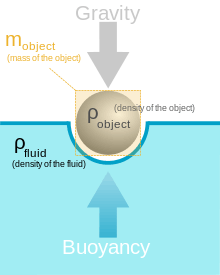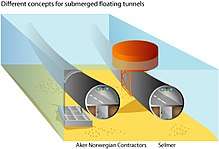Submerged floating tunnel

A submerged floating tunnel (SFT), also called a suspended tunnel or Archimedes bridge, is a proposed design for a tunnel that floats in water, supported by its buoyancy (specifically, by employing the hydrostatic thrust, or Archimedes' principle).[1]
The tube would be placed underwater, deep enough to avoid water traffic and weather, but not so deep that high water pressure needs to be dealt with—usually 20–50 m (60–150 ft) is sufficient. Cables either anchored to the Earth[1] or to pontoons at the surface[2] would prevent it from floating to the surface or submerging, respectively.
Construction

The concept of submerged floating tunnels is based on well-known technology applied to floating bridges and offshore structures, but the construction is mostly similar to that of immersed tunnels: One way is to build the tube in sections in a dry dock; then float these to the construction site and sink them into place, while sealed; and, when the sections are fixed to each other, the seals are broken. Another possibility is to build the sections unsealed, and after welding them together, pump the water out.
The ballast used is calculated so that the structure has approximate hydrostatic equilibrium (that is, the tunnel is roughly the same overall density as water), whereas immersed tube tunnels are ballasted more to weight them down to the sea bed. This, of course, means that a submerged floating tunnel must be anchored to the ground or to the water surface to keep it in place (which of these depends on which side of the equilibrium point the tunnel is).
Applications

Submerged floating tubes allow construction of a tunnel in extremely deep water, where conventional bridges or tunnels are technically difficult or prohibitively expensive. They would be able to deal with seismic disturbances and weather events easily (as they have some degree of freedom in regards to movement), and their structural performance is independent of length (that is, it can be very long without compromising its stability and resistance).
On the other hand, they may be vulnerable in regards to anchors or submarine traffic, which therefore has to be taken in consideration when building one.
Likely applications include fjords, deep, narrow sea channels, and deep lakes.[3]
Proposals
A submerged floating tunnel has never been built (as of 2016), but several proposals have been presented by different entities.
| Date | Place | Country | Proposer | link |
|---|---|---|---|---|
| late 1800s | English Channel | United Kingdom | Sir Edward James Reed | [4] |
| 1969 | Strait of Messina | Italy | Alan Grant | [5] |
| 1998 | Høgsfjorden | Norway | Norwegian Public Roads Administration | [6][7][8][9] |
| April 16, 2003 | Transatlantic tunnel | N/A | Discovery Channel's Extreme Engineering (Season 1, episode 3) | [10] |
| June 6, 2017 | Multiple potential sites | N/A | Hyperloop One | [11] |
| ? | Funka Bay, Hokkaido | Japan | Society of Submerged Floating Tunnel Technology | [12][13] |
| ? | Lake Washington, Seattle | United States | James Felch / Subterra, Inc. | [5][13][14] |
| ? | Vancouver Island | Canada | Ministry of Transportation of British Columbia, Canada | [15] |
| ? | Lugano Lake | Switzerland | [5] | |
| Cook Strait | New Zealand | Stuff.co.nz
t |
[16] |
Europe
Ponte di Archimede International, an Italian company, investigated the SFT in collaboration with the Norwegian Roads Research Laboratory,[17] the Danish Road Institute and the Italian Shipping Register, with a financial grant from the European Union and the coordination of FEHRL (Forum European National Highway Research Laboratories) an International Association of over 30 National Road Centres.[18] Furthermore, the Provincial Administrations of Como (Como Lake) and Lecco, in Italy, have officially shown great interest in the Archimedes' Bridge for crossing the Lario and the study of the submerged floating tunnel in the Strait of Messina has been promoted by Ponte di Archimede S.p.A. and verified with a feasibility analysis by the Italian Naval Register (RINA).[19]
In Norway, interest has been revived with Norwegian Public Roads Administration (NPRA) investigating the technical and economic potential for eliminating all ferries on fjord crossings along the western corridor (European route E39) between Kristiansand and Trondheim.[20][21] This project also linked with FEHRL through the Forever Open Road programme.[22] If the project were to proceed it estimated to cost $25 billion and be completed by 2035.[23]
China
The SIJLAB (Sino-Italian Joint Laboratory of Archimedes' Bridge), created in 1998, between Institute of Mechanics, Chinese Academy of Sciences, China and Ponte di Archimede S.p.A., is financed by the Italian Ministry of Foreign Affairs, the Chinese Ministry of Science and Technology and the Institute of Mechanics of the Chinese Academy of Sciences.
The consortium has started to build a 100m demonstration tunnel in Qiandao Lake in China eastern province of Zhejiang. Inside it, two layers of one-way motorways will run through in the middle, with two railway tracks flanking them.[24] The Qiandao Lake prototype will serve to help plan for the project of a 3,300-meter submerged floating tunnel in the Jintang Strait, in the Zhoushan archipelago, also situated in Zhejiang.[25][26][27]
According to Elio Matacena, the President of Ponte di Archimede International, the only difficulty building such tunnels in deeper waters is the price of the structure. Namely, the cables, which are very expensive, would be very long. He also notes that the tunnel is capable of supporting more weight than a traditional bridge, which has very strict weight limits, while being up to two times cheaper. Matacena points out that environmental studies show that the tunnel would have a very low impact on aquatic life.[28]
Indonesia
Indonesia has also expressed interest in the technology. For the infrastructure that would connect Sumatra to Java Island two options were explored: a conventional bridge or an undersea tunnel.
In 2004 the tunnel option was more widely discussed, especially when Kwik Kian Gie, then the Minister of National Development, announced that a European consortium was interested in investing in an undersea tunnel between Java and Sumatra. The budget was said to be around 15 billion US dollars for an undersea tunnel in the Sunda Strait; in the long term it would link up Java and Sumatra in an uninterrupted chain. The project was to begin construction in 2005 and be ready to use by 2018, and was a part of the Asian Highway.[29]
However, the bridge option was later favored.[30]
In 2007, Indonesian experts, led by Ir. Iskendar, Director for the Center of Assessment and Application of Technology for Transportation System and Industries, participated in a meeting with SIJLAB engineers, from the Sino-Italian Archimedes Bridge project.[26][31] As an archipelagic country, consisting of more than 13 thousand islands, Indonesia could benefit from such tunnels. Conventional transportation between islands is mainly by ferry. Submerged floating tunnels could thus be an alternative means to connect adjacent islands, in addition to normal bridges.
See also
References
- 1 2 Zanchi, Flores (July 2002). "Archimedes Bridge". Floornature. Archived from the original on 2008-01-11. Retrieved 2007-02-11.
- ↑ "Italian bridges cultures". Beijing Official Web Portal. Archived from the original on 2008-01-11. Retrieved 2007-09-13.
- ↑ ITA: A New Development: The Submerged Floating Tunnel Archived 2008-02-05 at the Wayback Machine.
- ↑ Tunnel Visions; July 1997; Scientific American Magazine; by Gary Stix
- 1 2 3 http://www.daps.unina.it/doc/doc_new/Brochure_Sijlab.pdf
- ↑ "Konkurranse om fjordkryssing" Norwegian Public Roads Administration, 7 May 2012. Accessed: 13 October 2013.
- ↑ "Ferry-free E39: Rørbruer (Tube bridges)" page 60 Norwegian Public Roads Administration, December 2012. Accessed: 13 October 2013.
- ↑ Rørbru
- ↑ Norwegian Submerged Floating Tunnel Company AS Archived January 10, 2008, at the Wayback Machine.
- ↑ Discovery Channel:: Extreme Engineering: Transatlantic Tunnel Archived 2011-09-27 at the Wayback Machine. – Interactive presentation of the theoretical structure of the transatlantic tunnel
- ↑ Hyperloop One reveals its plans for connecting Europe - Engadget
- ↑ Sato Motohiro, Kanie Shunji and Mikami Takashi (Graduate School of Engineering, Hokkaido University): Wave response characteristics of Submerged Floating Tunnel modeled as a beam on elastic foundation Archived 2008-10-30 at the Wayback Machine.. Journal of Structural Engineering, vol. 48A; No.1; pp 27–34 (2002)
- 1 2 "Groups promoting the SFT concept". Norwegian Submerged Floating Tunnel Company AS. Archived from the original on 2008-10-24. Retrieved 2008-08-22.
- ↑ "Submerged Floating Tunnel across Lake Washington" (PDF). SubTerra, Inc. 2001.
- ↑ "A Potential Fixed Link to Vancouver Island". Ministry of Transportation, British Columbia. 2001. Archived from the original on 2010-08-21.
- ↑ "Is it time for a Cook Strait bridge or tunnel?". Stuff. Retrieved 2018-02-20.
- ↑ http://www.fehrl.org/index.php?m=203
- ↑ http://www.fehrl.org
- ↑ "Ponte di Archimede S.p.A. — Research and Development" (PDF). pp. 6–7. Archived from the original (PDF) on 2011-07-15. Retrieved 2008-08-22.
- ↑ Olav Ellevset. "Coastal Highway Route E39" (PDF). Norwegian Public Roads Administration. Retrieved 13 October 2013.
- ↑ Aarian Marshall (14 July 2016). "Yes, a 'Submerged Floating Bridge' Is a Reasonable Way to Cross a Fjord". Wired.
- ↑ http://www.foreveropenroad.eu/?m=19
- ↑ "Norway Pioneers First Floating Underwater Tunnels". Born To Engineer. 11 August 2016.
- ↑ China to build world's 1st 'Archimedes bridge'
- ↑ "Archimedes Bridge". Ponte di Archimede International S.p.A. Archived from the original on 2008-01-10.
- 1 2 "First Archimedes bridge prototype to be realized in southern China". People's Daily Online. April 18, 2007.
- ↑ Zhejiang University Health Monitoring & Controlling Studying of Large-scale Bridge & Tunnel Structure (2006). "Research about suspending tunnel". Archived from the original on 2008-01-11.
- ↑ Maria Pia Medina Luna (2006-10-21). "Le premier pont-tunnel submergé reliera en Chine le continent à une île sur 3 200 m" (in French). L'Internaute — Magazine Savoir. (in French)
- ↑ "Archived copy". Archived from the original on 2004-05-04. Retrieved 2008-08-22. (in Indonesian)
- ↑ "Archived copy". Archived from the original on 2008-05-19. Retrieved 2008-08-22. (in Indonesian)
- ↑ Institute of Mechanics, Chinese Academy of Sciences: Indonesian Experts visited IMECH Archived 2007-12-18 at the Wayback Machine.
Further reading
- research papers
- Mariagrazia Di Pilato; Anna Feriani; Federico Perotti (17 March 2008). "Numerical models for the dynamic response of submerged floating tunnels under seismic loading". Earthquake Engineering & Structural Dynamics, Volume 37 Issue 9, pages 1203–1222.
- FEHRL – Forum of European National Highway Research Laboratories (17 March 2008). "Analysis of the submerged floating tunnel concept". Report no 1996/2a, ISSN 1362-6019.
- Strait Crossings 2001, by Jon Krokeborg. pages 511–590
- videos
- Video describing several proposals for crossing the Sognefjord by the Norwegian Public Roads Administration. A submerged floating tunnel is described at 4:24.
- Video explaining some of the concepts of an Archimedes bridge
- Italian television news covering the Quiandao Lake Project (in Italian)
- Another news coverage of the Sino-Italian project (in Italian)
- companies